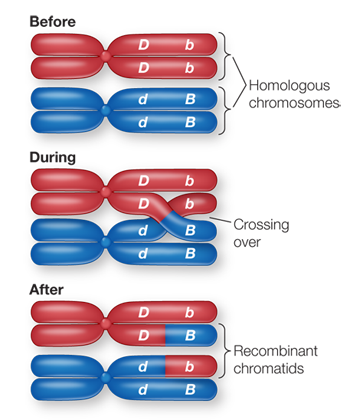Apply What You’ve Learned
Review
12.4
Genes on the same chromosome are linked.
12.4
Recombinant frequencies can be used to infer gene locations on a chromosome.
Fruit flies (Drosophila melanogaster) seem to appear out of nowhere, hovering around bananas, peaches, and other ripe fruit. Biologists, having traced fruit fly origins to West Africa, have hypothesized that expansion of the range of Drosophila occurred with human assistance. Drosophila can now be found almost everywhere in the world. Though pesky in the kitchen, fruit flies are important laboratory organisms—
Suppose you were studying fruit flies, looking at easily identified traits encoded by three genes on the same autosomal chromosome. The gene loci are summarized in the figure below. The lowercase letter in each represents the recessive allele; the capital letter represents the dominant allele. The numbers indicate the location in map units of each gene on the chromosome.

Questions
1.
Give the genotypes and phenotypes of the F1 and F2 generations produced from the cross DDbb × ddBB, assuming no crossing over occurs. Also assume that the F2 generation is produced by interbreeding the F1 generation.
F1 genotype: 100% DdBb
F1 phenotype: 100% long legs, gray body
F2 genotypes: 1:2:1 ratio 25% DDbb:50% DdBb:25% ddBB
F2 phenotypes: 25% long legs, black body; 50% long legs, gray body; 25% short legs, gray body
F1 genotype: 100% BbCc
2.
Give the genotypes and phenotypes of the F1 and F2 generations produced from the cross BBcc × bbCC, assuming no crossing over occurs. Also assume that the F2 generation is produced by interbreeding the F1 generation.
F1 phenotype: 100% gray body, straight wings
F2 genotypes: 1:2:1 ratio 25% BBcc:50% BbCc:25% bbCC
F2 phenotypes: 25% gray body, curved wings; 50% gray body, straight wings; 25% black body, straight wings
3.
For each of the crosses above, what further phenotypes would appear in the offspring if crossing over occurred? In which cross would you find a higher frequency of recombinants resulting from crossing over? Explain.
In the F2 generation of the DDbb × ddBB cross, you would also find the short legs, black body phenotype (ddbb genotype), which would be a new phenotype not observed earlier.
In the second case, the F2 generation of the BBcc × bbCC cross, you would find the black body, curved wings phenotype (bbcc genotype), which would be a new phenotype not observed earlier.
The BBcc × bbCC cross would produce the larger frequency of recombinants because the distance between the two linked loci (B and C) is longer (75.5 – 48.5= 27.0 map units) than the distance between the two linked loci (D and B) (48.5 – 31.0=17.5 map units). There is a greater probability of crossing over with a longer distance between linked loci.
4.
Draw the chromosomes at the stage where crossing over occurs in meiosis in the DDbb × ddBB cross in Question 1 above. Show the chromosomes and chromatids before, during, and after crossing over. Clearly label the genes and alleles.
